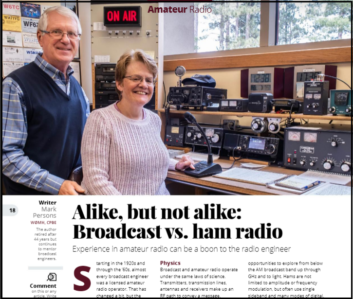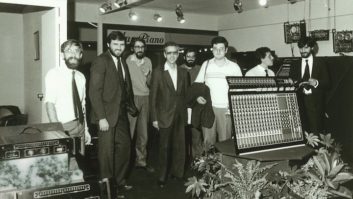 The following are in response to the Mark Persons article “Alike but Not Alike: Broadcast vs. Ham Radio.”
The following are in response to the Mark Persons article “Alike but Not Alike: Broadcast vs. Ham Radio.”
Well said
Having been an amateur radio operator for more than 67 years (and an occasional contributor to Radio World), I want to compliment Mark Persons on his article in the Oct. 27 issue.
It is the best explanation of the amateur radio hobby that I have ever read. There is nothing more that I could add to describe “hamming” to both the technical and non-technical, and I will rely on it to explain and recruit more hams to our hobby. 73.
John Seibels, K4AXV
Remembering the magic
I was a broadcaster first for a number of years and didn’t get licensed in amateur radio until 1990. In the early years, it seemed that many of the engineers I worked with were hams. Maybe not so much anymore. But one of them proved a worthy “Elmer” to me and got me up and running on ham over 30 years ago.
There are indeed many similarities, at least in the technical aspects. When I started in broadcasting, a Third Class License was required. Every person overseeing an air shift needed to take transmitter readings to ensure compliance in power output. Other “off-air” duties included making sure we powered down or up at the appropriate times to sunrise or sunset, check the tower lights and other similar tasks.
As time went on, the Third Class requirement was dropped, as were the requirements of the broadcasters to be knowledgeable of power readings, and such.
They were fun years: two turntables, three cart decks and a microphone staring you in the face. No automation, no computers. Even having time to use the bathroom on a six-hour shift was pretty much limited to the 4½-minute UPI news feed at the top of the hour.
My last years in broadcasting were distilled down to recording cuts and saving them with specified file names.
Of course, ham radio is more recreational. The content is not controlled by a station log but by the person on the other end of the QSO.
But there was still the magic of being on the other side of a microphone. If conditions were good, it was not unusual for me to work a number of QSOs before and after being on the air as a broadcaster.
I am grateful for the broadcast engineers I’ve known over the years, keeping us on the air with our broadcast stations as well as helping me get into ham radio. 73.
Scott McIntire, K7DXT
On the same frequency
I live in the Washington area and have been a pro broadcaster since 1979, but I didn’t jump into amateur radio until 2009. When I did it was with both feet. I even changed my ringtone on my cellphone to the Morse characters CQ, which hams use to call out over the air to talk to other hams.
As a frequent commuter bus rider, I often have to transfer at the Pentagon bus depot. Many of my fellow passengers are military folks who disembark there for their day of duties.
One morning my phone rang — “dah-dit-dah-dit, dah-dah-dit dah.”
I heard a loud guffaw went up from the back of the bus. One of the other passengers — either a ham or part of the Signal Corps — recognized the pattern and got my joke.
Broadcast radio and ham radio. Love ’em both.
Alan Peterson, KJ4IVD
National Production Director & Second Engineer
Radio America Network







